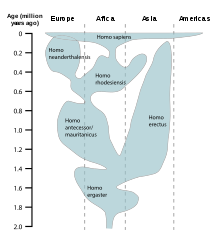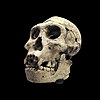人属
| 人属 化石时期:上新世-现代
| |
|---|---|

| |
| 从左上顺时针方向依次为: 尼安德塔人 (Homo neanderthalensis) , 智人 (Homo sapiens), 能人(Homo habilis) ,北京猿人 (Homo erectus pekinensis). | |
| 科学分类 | |
| 界: | 动物界 Animalia |
| 门: | 脊索动物门 Chordata |
| 纲: | 哺乳纲 Mammalia |
| 目: | 灵长目 Primates |
| 科: | 人科 Hominidae |
| 亚科: | 人亚科 Homininae |
| 族: | 人族 Hominini |
| 亚族: | 人亚族 Hominina |
| 属: | 人属 Homo Linnaeus, 1758 |
| 模式种 | |
| 智人 Homo sapiens Linnaeus, 1758
| |
| 种 | |
| |
| 异名 | |
|
异名
| |
人属(学名:Homo,来自拉丁语 homō,意即:“人类”)是源自南方古猿属的人科属,包括现存物种智人(现代人类)和许多灭绝物种(统称为早期智人,包括直立人和尼安德特人等),后者被归类为现代人类的祖先或与之关系密切。本属最古老的成员是能人,已知证据显示其存在于超过200万年前。人属和傍人属可能与南方古猿属的非洲南方古猿物种关系最密切。[1] 现存与人属基因关系最近的近亲是黑猩猩属(包括黑猩猩和倭黑猩猩);据估计,黑猩猩属和人属的祖先在大约5.7至11百万年前的晚中新世时期出现分歧。[2]
直立人约出现在200万年前,并透过几次迁徙散布到整个非洲大陆(参看匠人)及欧亚大陆。作为一个适应性强且成功的物种,它持续超过1百万年,并在约50万年前逐渐分化为新物种。[3]
解剖学上的现代人类(智人),约在30万到20万年前出现在非洲[4],而尼安德塔人约在同一时间出现在欧洲和西亚地区。智人自非洲扩散多次,可能早在25万年前,也在13万年前,其中所谓南方扩散(英语:Southern Dispersal)开始于约70至5万年前[5][6][7],到5万年前对欧亚大陆和大洋洲的持续移民(参看早期人类迁徙)。智人在非洲和欧亚大陆与早期智人相遇并杂交。[8][9]
特征
[编辑]人属最大的特点是其发达的脑。在二百万年的进化中其脑的容量扩大了三倍。
在人科中人属的特点是:
- 特别大的头颅容量
- 前额直立
- 不断增大的脑,尤其是大脑
- 咀嚼肌肉的退缩
- 牙齿的大小逐渐相近,逐渐减小
- 上下颌逐渐变小
- 手逐渐灵活
- 产道变阔,变得不再那么顺直[10]
- 雌性乳房变大(无法在化石中验证这是否也适应于已灭绝的人种)
物种
[编辑]
能人(H. habilis)从南方古猿分支出来,具有比南方古猿更小的大臼齿和更大的脑容量,并运用石头或骨骼制作工具,可能栖息在树上,而非直立行走[11]。
在更新世早期,距今150万到100万年间的非洲、亚洲与欧洲,某些能人群体发展出较大的脑子,并制作更进步的石器,会使用火,被称为直立人。最有名的直立人标本是北京人,此外在印尼、非洲、欧洲出土。匠人可能距今180万到125万年前的直立人,或是直立人的亚种。直立人可能由于多峇巨灾而灭绝。[12]
尼安德特人在大约公元前7万5000年与智人混血,因此非洲以外的现代人的DNA约有1%到4%源自尼安德特人[13]。来自智人的竞争,可能导致了尼安德特人的灭绝[14][15]。
智人是人属中现存的唯一物种,从直立人演化而来。根据单地起源说,智人从非洲向外迁移,最终取代了较早散居各地的直立人。
已灭绝物种
[编辑]| 名称 | 学名 | 时间(万年前) | 发现地点 | 图片 | |
|---|---|---|---|---|---|
| 最早 | 最晚 | ||||
| LD 350-1 | Homo sp.? | 280 | 275 | 于2013年在埃塞俄比亚的阿法尔州的Ledi-Geraru研究区出土[16] | 
|
| 纳莱迪人 | Homo naledi | 33.5 | 23.6 | 南非豪登省 | 
|
| 鲁道夫人 | Homo rudolfensis | 240 | 160 | 东非肯尼亚[17],马拉维 | 
|
| 能人 | Homo habilis | 250 | 200 | 坦桑尼亚奥杜瓦伊峡谷 | 
|
| 格鲁吉亚原人 | Homo georgicus | 180 | 160 | 格鲁吉亚德马尼西 | 
|
| 匠人 | Homo ergaster | 180 | 140 | 东非,南非,格鲁吉亚 | 
|
| 豪登人 | Homo gautengensis | 200 | 80 | 南非豪登省 | 
|
| 直立人 | Homo erectus | 170 | 30 | 阿尔及利亚,中国,爪哇 | 
|
| 先驱人 | Homo antecessor | 90 | 西班牙布尔戈斯 | 
| |
| 西布兰诺人 | Homo cepranensis | 80 | 意大利弗罗西诺内省 | 
| |
| 博多人 | Homo bodoensis | 75 | 13 | 欧洲,南非,东非 | 
|
| 罗德西亚人 | Homo rhodesiensis | 60 | 12.5 | 赞比亚,南非,埃塞俄比亚,坦桑尼亚 | 
|
| 海德堡人 | Homo heidelbergensis | 60 | 10 | 欧洲,东非 | 
|
| 尼安德塔人 | Homo neanderthalensis | 20 | 3 | 中东,欧洲 | 
|
| 佛罗勒斯人 | Homo floresiensis | 9.4 | 1.3 | 印尼弗洛勒斯岛,东南亚[18][19] | 
|
| 吕宋人 | Homo luzonensis | 6.7 | 5 | 菲律宾吕宋岛,东南亚[20] | 
|
| 澎湖原人 | Penghu 1 / Homo tsaichangensis | 45 | 19 | 台湾海峡[21][22] | 
|
| 丹尼索瓦人 | Homo sp. | 16 | 3 | 西伯利亚、青藏高原[23] | 
|
| 龙人 | Homo longi | 30.9 | 13.8 | 中国黑龙江省 | 
|
| 长者智人 | Homo sapiens idaltu | 16 | 15.4 | 埃塞俄比亚 | 
|
| 马鹿洞人 | Homo sp. | 1.43 | 1.15 | 中国广西 | 
|
| 巨颅人 | Homo juluensis | 20 | 16 | 中国许家窑 | |
| 波多人 | Homo bodoensis | 75 | 13 | 埃塞俄比亚 | 
|
系统发生学
[编辑]| 人猿总科 |
| ||||||||||||||||||||||||
| (20.4 Mya) |
| 人亚族 (南猿亚族) |
| |||||||||||||||||||||||||||||||||||||||||||||||||||||||||||||||||||||||||||||||||||||||||||||||||||
| (7.3 Mya) |
参考文献
[编辑]- ^ Haile-Selassie Y, Gibert L, Melillo SM, Ryan TM, Alene M, Deino A, et al. New species from Ethiopia further expands Middle Pliocene hominin diversity. Nature. May 2015, 521 (7553): 483–8. Bibcode:2015Natur.521..483H. PMID 26017448. S2CID 4455029. doi:10.1038/nature14448.
- ^ Foley, Robert A.; Mirazón Lahr, Marta. Ghosts of extinct apes: genomic insights into African hominid evolution. Trends in Ecology & Evolution. January 2024, 39 (5): 456–466. Bibcode:2024TEcoE..39..456F. PMID 38302324. doi:10.1016/j.tree.2023.12.009
 (英语).
(英语).
- ^ Indriati, Etty; Swisher, Carl C.; Lepre, Christopher; Quinn, Rhonda L.; Suriyanto, Rusyad A.; Hascaryo, Agus T.; Grün, Rainer; Feibel, Craig S.; Pobiner, Briana L.; Aubert, Maxime; Lees, Wendy. The Age of the 20 Meter Solo River Terrace, Java, Indonesia and the Survival of Homo erectus in Asia. PLoS ONE. 2011-06-29, 6 (6). ISSN 1932-6203. PMC 3126814
 . PMID 21738710. doi:10.1371/journal.pone.0021562.
. PMID 21738710. doi:10.1371/journal.pone.0021562.
- ^ Callaway, E. Oldest Homo sapiens fossil claim rewrites our species' history. Nature. 7 June 2017 [11 June 2017]. doi:10.1038/nature.2017.22114.
- ^ Posth C, Renaud G, Mittnik A, Drucker DG, Rougier H, Cupillard C, et al. Pleistocene Mitochondrial Genomes Suggest a Single Major Dispersal of Non-Africans and a Late Glacial Population Turnover in Europe. Current Biology. March 2016, 26 (6): 827–33. Bibcode:2016CBio...26..827P. PMID 26853362. S2CID 140098861. doi:10.1016/j.cub.2016.01.037. hdl:2440/114930
 .
.
- ^ See:
- Karmin M, Saag L, Vicente M, Wilson Sayres MA, Järve M, Talas UG, et al. A recent bottleneck of Y chromosome diversity coincides with a global change in culture. Genome Research. April 2015, 25 (4): 459–66. PMC 4381518
 . PMID 25770088. doi:10.1101/gr.186684.114.
. PMID 25770088. doi:10.1101/gr.186684.114. - Pagani L, Lawson DJ, Jagoda E, Mörseburg A, Eriksson A, Mitt M, et al. Genomic analyses inform on migration events during the peopling of Eurasia. Nature. October 2016, 538 (7624): 238–242. Bibcode:2016Natur.538..238P. PMC 5164938
 . PMID 27654910. doi:10.1038/nature19792.
. PMID 27654910. doi:10.1038/nature19792.
- Karmin M, Saag L, Vicente M, Wilson Sayres MA, Järve M, Talas UG, et al. A recent bottleneck of Y chromosome diversity coincides with a global change in culture. Genome Research. April 2015, 25 (4): 459–66. PMC 4381518
- ^ Haber M, Jones AL, Connell BA, Arciero E, Yang H, Thomas MG, et al. A Rare Deep-Rooting D0 African Y-Chromosomal Haplogroup and Its Implications for the Expansion of Modern Humans Out of Africa. Genetics. August 2019, 212 (4): 1421–1428. PMC 6707464
 . PMID 31196864. doi:10.1534/genetics.119.302368.
. PMID 31196864. doi:10.1534/genetics.119.302368.
- ^ Green RE, Krause J, Briggs AW, Maricic T, Stenzel U, Kircher M, et al. A draft sequence of the Neandertal genome. Science. May 2010, 328 (5979): 710–722. Bibcode:2010Sci...328..710G. PMC 5100745
 . PMID 20448178. doi:10.1126/science.1188021.
. PMID 20448178. doi:10.1126/science.1188021.
- ^ Lowery RK, Uribe G, Jimenez EB, Weiss MA, Herrera KJ, Regueiro M, Herrera RJ. Neanderthal and Denisova genetic affinities with contemporary humans: introgression versus common ancestral polymorphisms. Gene. November 2013, 530 (1): 83–94. PMID 23872234. doi:10.1016/j.gene.2013.06.005. This study raises the possibility of observed genetic affinities between archaic and modern human populations being mostly due to common ancestral polymorphisms.
- ^ 科林·巴拉斯. 分娩痛苦和危險的真正原因. 2017-01-27 [2019-06-09]. (原始内容存档于2020-09-19) (英国英语).
- ^ Wood, B. & Collard, M.(1999)The changing face of Genus Homo. Evol. Anth. 8(6)195-207
- ^ Spoor F, Wood B, Zonneveld F. Implications of early hominid labyrinthine morphology for evolution of human bipedal locomotion. Nature. 1994, 369 (6482): 645–8. PMID 8208290. doi:10.1038/369645a0.
- ^ Jennifer Viegas. Neanderthals, humans interbred, DNA proves. Discovery News. 2010-05-06 [2010-08-17]. (原始内容存档于2010-08-18).
- ^ Diamond, Jared. The Third Chimpanzee: The Evolution and Future of the Human Animal. Harper Perennial. 1992. ISBN 0060984031.
- ^ How Neanderthals met a grisly fate: devoured by humans (页面存档备份,存于互联网档案馆). The Observer. May 17, 2009.
- ^ Erin N. DiMaggio et al.: Late Pliocene fossiliferous sedimentary record and the environmental context of early Homo from Afar, Ethiopia. In: Science. Online-Vorabveröffentlichung vom 4. März 2015, doi:10.1126/science.aaa1415
- ^ Wood B. 'Homo rudolfensis' Alexeev, 1986-fact or phantom?. J. Hum. Evol. 1999, 36 (1): 115–8. PMID 9924136. doi:10.1006/jhev.1998.0246.
- ^ Brown, P.; Sutikna, T., Morwood, M. J., Soejono, R. P., Jatmiko, Wayhu Saptomo, E. & Rokus Awe Due. A new small-bodied hominin from the Late Pleistocene of Flores, Indonesia.. Nature. October 27, 2004, 431: 1055–1061. doi:10.1038/nature02999.
- ^ Morwood, M. J.; Soejono, R. P., Roberts, R. G., Sutikna, T., Turney, C. S. M., Westaway, K. E., Rink, W. J., Zhao, J.- X., van den Bergh, G. D., Rokus Awe Due, Hobbs, D. R., Moore, M. W., Bird, M. I. & Fifield, L. K. Archaeology and age of a new hominin from Flores in eastern Indonesia.. Nature. October 27, 2004, 431: 1087–1091. doi:10.1038/nature02956.
- ^ Détroit, F.; Mijares, A. S.; Corny, J.; Daver, G.; Zanolli, C.; Dizon, E.; Robles, E.; Grün, R.; Piper, P. J. A new species of Homo from the Late Pleistocene of the Philippines. Nature. 2019, 568 (7751): 181–186. doi:10.1038/s41586-019-1067-9.
- ^ Chang, C.-H.; Kaifu, M.; Kona, R. T.; Grün, R.; Matsu'ura, S.; Kinsley, L.; Lin, L.-K. First archaic Homo from Taiwan. Nature Communications. 2015. doi:10.1038/ncomms7037.
- ^ McMenamin, M. A. S. Homo tsaichangensis and Gigantopithecus. South Hadley, Massachusetts: Meanma. 2015. ISBN 1-893882-19-5. doi:10.13140/2.1.3463.7121.
- ^ David Reich; Richard E. Green, Martin Kircher, Johannes Krause, Nick Patterson, Eric Y. Durand, Bence Viola, Adrian W. Briggs, Udo Stenzel, Philip L. F. Johnson, Tomislav Maricic, Jeffrey M. Good, Tomas Marques-Bonet, Can Alkan, Qiaomei Fu, Swapan Mallick, Heng Li, Matthias Meyer, Evan E. Eichler, Mark Stoneking, Michael Richards, Sahra Talamo, Michael V. Shunkov, Anatoli P. Derevianko, Jean-Jacques Hublin et al. Genetic history of an archaic hominin group from Denisova Cave in Siberia. NATURE. 23 December 2010, (468): 1053–1060 [2011-01-10]. doi:10.1038/nature09710. (原始内容存档于2010-12-25).





